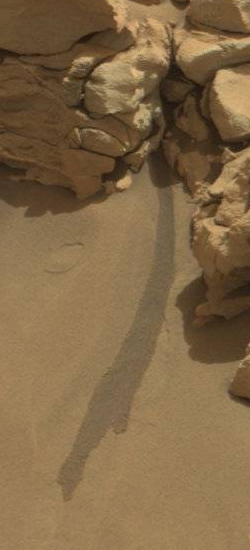It looks like you're using an Ad Blocker.
Please white-list or disable AboveTopSecret.com in your ad-blocking tool.
Thank you.
Some features of ATS will be disabled while you continue to use an ad-blocker.
share:
originally posted by: Blue Shift
Yeah, I found that a year and a half or so ago, and we in the Anomalies thread pretty much concluded that it was just probably just slightly darker sand, without any fluid in it.
The presence of water will make sand turn a darker color. If you have ever played on a beach and tried to make sandcastles with moats, you'll know that water will diffuse between the sand grains and that solid objects will prevent water from evaporating creating a pico-climate. The top layers of sand can be golden-yellow, soft and dry, while the lower layers will be light brown in color, clump together, while going down six inches, the sand will be more like mud and just run out of your fingers.
The way that the discolored soil has moved and formed a spherical drop on the right side, looks like a trickle of liquid.
originally posted by: Benicealways
You found that? Really? That's awesome, but slightly darker sand just randomly appearing in the form just as how water would seep down a hill?
If you look a little closer at it, you can see that it doesn't exactly follow the contours and irregularities of the sand the way something liquid would.

I could be wrong, though. It caught my attention because it looked like water. At that time, we were also looking at possible condensation droplets accumulating on the rover and creating little trails.
Well after we now know that there's water on Mars, I don't have to speculate whether it's water or not, to me this is water.
I question myself where does it come from? Looking at the pile of rocks and large amount of sand surrounding the rocks imo there has to be a kind of source under the pile of rocks, and vaporization causes the water to seep on the open sands?
I question myself where does it come from? Looking at the pile of rocks and large amount of sand surrounding the rocks imo there has to be a kind of source under the pile of rocks, and vaporization causes the water to seep on the open sands?
originally posted by: 0bserver1
I question myself where does it come from? Looking at the pile of rocks and large amount of sand surrounding the rocks imo there has to be a kind of source under the pile of rocks, and vaporization causes the water to seep on the open sands?
Yeah, that was another thing that made us think that it was just darker colored sand. It seems to come from a higher level up, and just falls down in that crack between the rocks. As it passes through the rocks, maybe it's sheltered from the sun enough to be less bleached out as it tumbles down into the lower area. Over time, it gets lighter, not because it dries up, but because the iron in the sand gets a patina on it, effectively bleaching it. So you have older, lighter little sand falls as the stuff gets lighter in color over time.
Otherwise, the briny water is heated up by a particular alignment of the sun on the rocks during certain times of year, creating a small "spring" in the crack that allows the melted water to trickle down.
a reply to: Benicealways
Hey, Benicealways! You have a Private Message (PM) from Staff. Check your inbox by clicking on the "envelope" icon in the upper-right corner of the page.
Thank you!
(Do not respond to this post.)
Hey, Benicealways! You have a Private Message (PM) from Staff. Check your inbox by clicking on the "envelope" icon in the upper-right corner of the page.
Thank you!
(Do not respond to this post.)
a reply to: Blue Shift
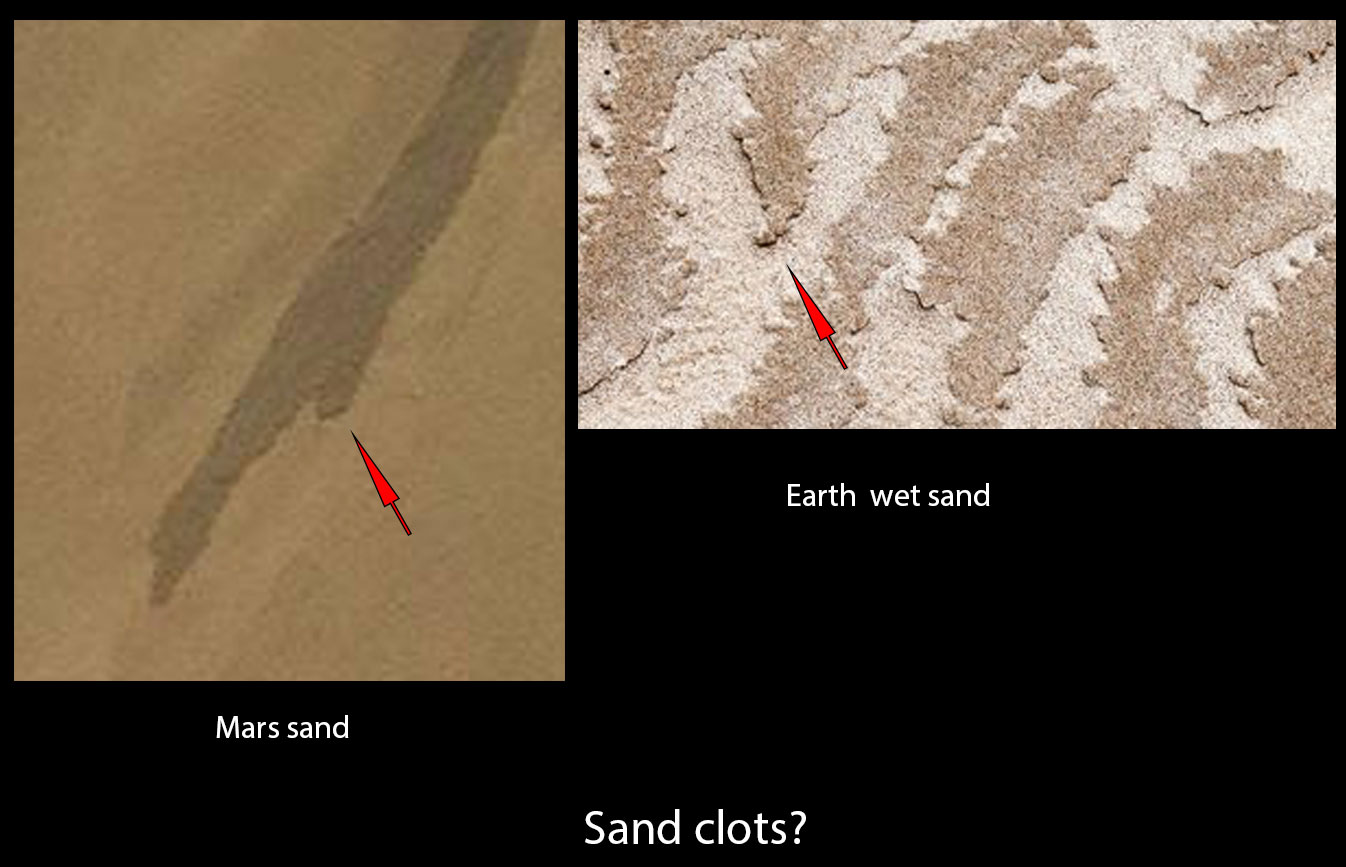
I don't know could be, but I think I can see sand clots and that can only happen with water I presume ?
maybe it's sheltered from the sun enough to be less bleached out as it tumbles down into the lower area. Over time, it gets lighter, not because it dries up, but because the iron in the sand gets a patina on it, effectively bleaching it. So you have older, lighter little sand falls as the stuff gets lighter in color over time.

I don't know could be, but I think I can see sand clots and that can only happen with water I presume ?
It's the martian sand, which is always darker than the thin coating of iron oxide covering (almost) everything on Mars.
Scooped-out sample:
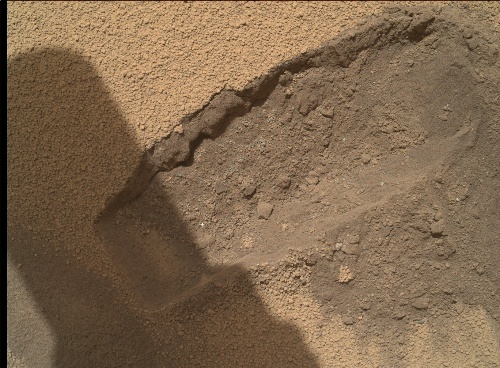
Curiosity's wheels displace alot of that stuff:
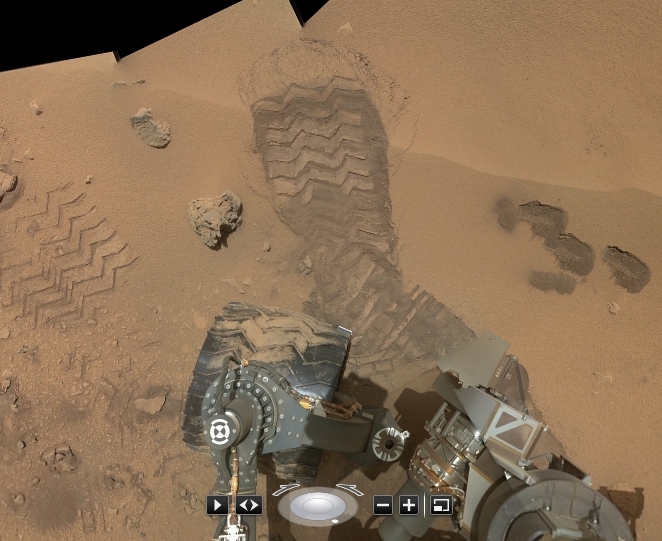
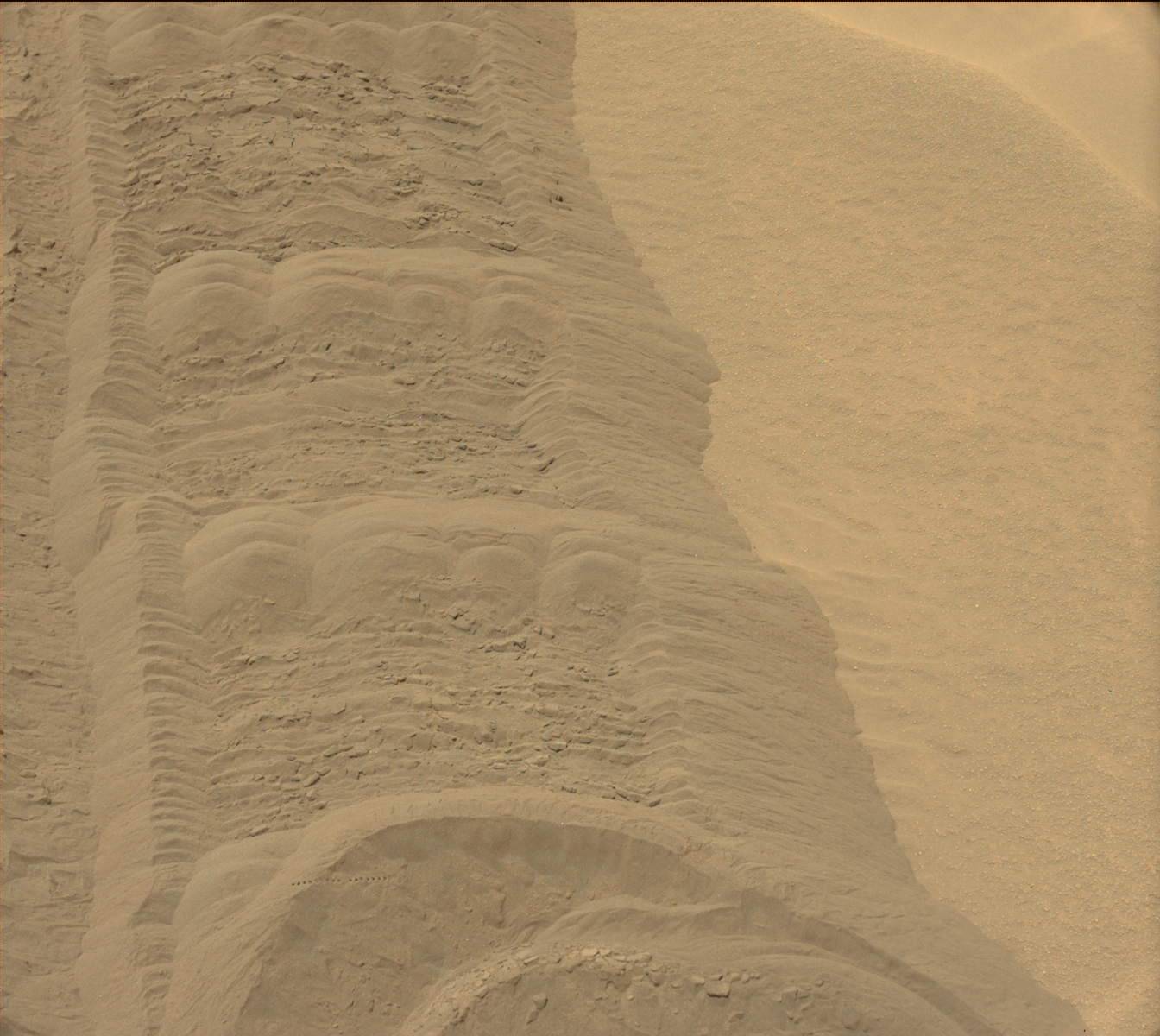
Scooped-out sample:

Curiosity's wheels displace alot of that stuff:


originally posted by: wildespace
It's the martian sand, which is always darker than the thin coating of iron oxide covering (almost) everything on Mars.
Scooped-out sample:
Yes that's true as given the sub 'soil' will be darker, I don't think that means it always follows in every scenario, and these are differing scenarios. But even in your scoop picture I've kept in, look at the top layer along the edges of the scoop..it's sand alright, but it is thinly crusted... like the pastry on a pie, and if that was always bone dry material all of the top sand would have just fallen away into the scoop hole, just like bone dry sand will, but that's not what has happened, and there is a certain amount of concretion going on at the top layer of sand, albeit very fragile. No matter how minute though, something has caused that, and the best bet is moisture. I might also argue with myself re the OP's feature, is this light sand made darker by moisture and newish or fresh, or is the 'older' streaks you see, what was dark sand lightened by the effect of water over time?
a reply to: Blue Shift
How can darker sand stay together and form a stripe like that in the midst of lighter sand? Even if it was denser or less dense, it wouldn't attract to like material unless it was magnetized or something. The darker sand theory just seems hard to fathom. Ice melting and then flowing down making that darker sand is much easier to believe.
How can darker sand stay together and form a stripe like that in the midst of lighter sand? Even if it was denser or less dense, it wouldn't attract to like material unless it was magnetized or something. The darker sand theory just seems hard to fathom. Ice melting and then flowing down making that darker sand is much easier to believe.
originally posted by: Tiamat384
I'm just going to point out. Your title sounds like a picture of liquid was found on Mars. A picture of it. Haha good find OP
Do you mean a pitcher?
I'm not trying to be a spelling nazi, I just truly do not understand what you mean.
edit on 10/23/2015 by 3n19m470 because: link showing an
example of a pitcher did not work
Mainstream media quickly got on the bandwagon:
www.express.co.uk
Sad, really. Probably won't be long before MSM stoop down to the level of Before It's News.
Sad, really. Probably won't be long before MSM stoop down to the level of Before It's News.
edit on 23-10-2015 by wildespace because: (no
reason given)
a reply to: Blue Shift
I agree not liquid, but you might not agree with my interpretation of electrostatic removal of the lighter coloured surface material. Pointy or sharp edged features are always more electrically active, and the slot where the fluid seems to originate has likely been cut by an electric wind. All the sand/dust in the images is not from wind erosion, it is electrostatic ablation, and the slots are field aligned ablation channels.
Yeah, I found that a year and a half or so ago, and we in the Anomalies thread pretty much concluded that it was just probably just slightly darker sand, without any fluid in it.
I agree not liquid, but you might not agree with my interpretation of electrostatic removal of the lighter coloured surface material. Pointy or sharp edged features are always more electrically active, and the slot where the fluid seems to originate has likely been cut by an electric wind. All the sand/dust in the images is not from wind erosion, it is electrostatic ablation, and the slots are field aligned ablation channels.
originally posted by: GaryN
a reply to: Blue Shift
Yeah, I found that a year and a half or so ago, and we in the Anomalies thread pretty much concluded that it was just probably just slightly darker sand, without any fluid in it.
I agree not liquid, but you might not agree with my interpretation of electrostatic removal of the lighter coloured surface material. Pointy or sharp edged features are always more electrically active, and the slot where the fluid seems to originate has likely been cut by an electric wind. All the sand/dust in the images is not from wind erosion, it is electrostatic ablation, and the slots are field aligned ablation channels.
Always electrically-active edges? Electric wind? This is some kind of different universe you're talking about than the one we live in. Sounds like an Electric Universe.
Yeah, but look. Here's something recent that is a result of the rover drilling a hole that shows kind of the same thing. The rover drilled a hole
and some dirt and dust flowed downhill. It's darker than the surrounding material, and looks pretty fluid. Did the rover strike water?
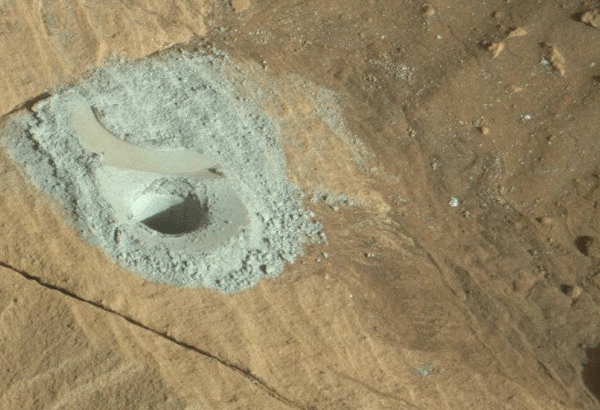
mars.jpl.nasa.gov...

mars.jpl.nasa.gov...
edit on 26-10-2015 by Blue Shift because: (no reason
given)
The important point surely is that whilst it may be evidence of a liquid, it is no more evidence of water than it is of Jack Daniels (which might
produce an identical effect) So, if there JD flowing on Mars? And if so, when is the next flight out there?
new topics
-
Watch as a 12 million years old Crab Emerges from a Rock
Ancient & Lost Civilizations: 2 hours ago -
ILLUMINATION: Dimensions / Degrees – Da Vincis Last Supper And The Philosophers Stone
Secret Societies: 8 hours ago -
Just Sick of It! Done! Can't take it anymore!
General Chit Chat: 9 hours ago -
Speaking of Pandemics
General Conspiracies: 11 hours ago -
Stuck Farmer And His Queue Jumping Spawn
Rant: 11 hours ago
top topics
-
Speaking of Pandemics
General Conspiracies: 11 hours ago, 9 flags -
Watch as a 12 million years old Crab Emerges from a Rock
Ancient & Lost Civilizations: 2 hours ago, 9 flags -
ILLUMINATION: Dimensions / Degrees – Da Vincis Last Supper And The Philosophers Stone
Secret Societies: 8 hours ago, 8 flags -
Just Sick of It! Done! Can't take it anymore!
General Chit Chat: 9 hours ago, 5 flags -
Stuck Farmer And His Queue Jumping Spawn
Rant: 11 hours ago, 4 flags
active topics
-
Joe Biden gives the USA's Highest Civilian Honor Award to Hillary Clinton and George Soros.
US Political Madness • 37 • : WeMustCare -
Candidate Harris Supporter MARK CUBAN Says Trump Has No Smart-Intelligent Women in His Orbit.
2024 Elections • 88 • : Oldcarpy2 -
Vehicle Strikes people in New Orleans
Mainstream News • 298 • : WeMustCare -
Matthew Livelsberger said he was being followed by FBI
Political Conspiracies • 72 • : WeMustCare -
Winter Storm
Fragile Earth • 30 • : RickinVa -
Watch as a 12 million years old Crab Emerges from a Rock
Ancient & Lost Civilizations • 9 • : FullHeathen -
-@TH3WH17ERABB17- -Q- ---TIME TO SHOW THE WORLD--- -Part- --44--
Dissecting Disinformation • 3941 • : WeMustCare -
Orbs Appear And Form Triangle On Live Cam.
Aliens and UFOs • 28 • : DaydreamerX -
Musk calls on King Charles III to dissolve Parliament over Oldham sex grooming gangs
Mainstream News • 173 • : Oldcarpy2 -
Nigel Farage's New Year Message.
Politicians & People • 24 • : gortex

